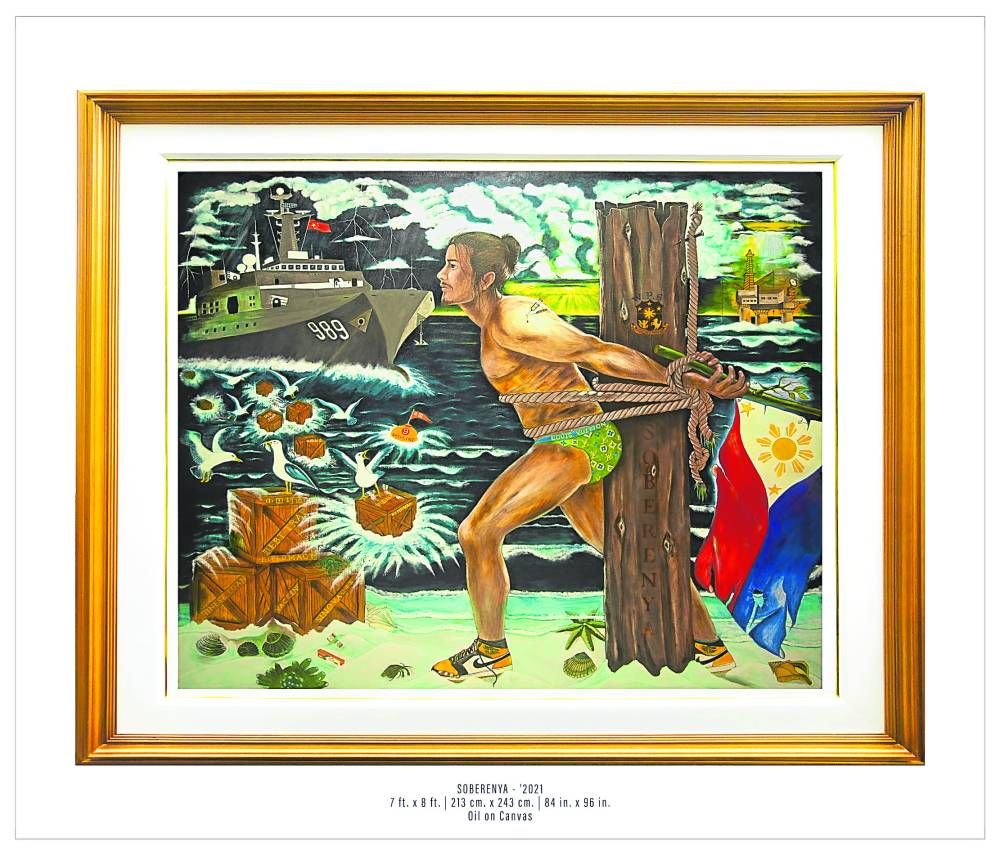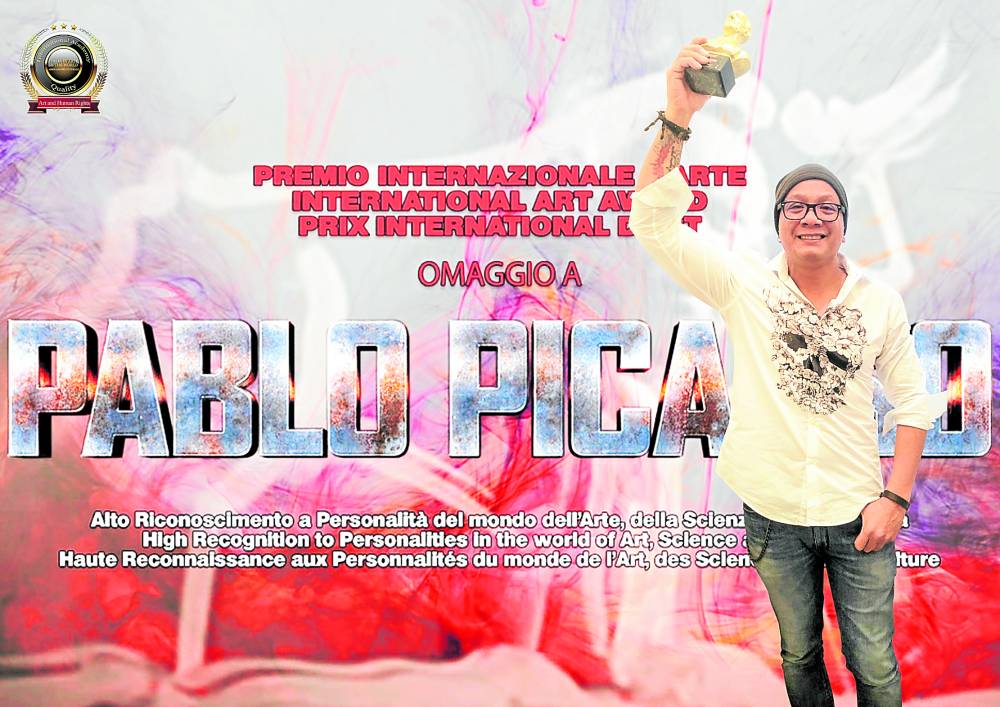
At 7 ft by 8 ft, the oil-on-canvas painting “Soberenya” by Paris-based Filipino artist Allanrey “Migz” Salazar sports the monumental dimensions of its monumental but mordant subject: how Philippine sovereignty and territorial integrity have been compromised by communist China’s military structures on the West Philippine Sea.
But that’s getting ahead of the story.
“Soberenya” was unveiled by Quezon City Mayor Joy Belmonte at the Quezon City Legislative Hall as City Hall’s contribution to the celebration of National Arts Month.
It seemed jarring for art lovers to have a red-letter day at the exhibit hall viewing Salazar’s darkly trenchant works, but the artist said “Soberenya” and his other creations come from the heart.
“Artists must go beyond their canvas and marble, their music and writing, their dance and film,” he explained. “[The artist is] compelled to have a purpose and advocacy concerning the current sociopolitical landscape.”
In “Soberenya,” the Filipino Everyman has his hands tied behind his back and his body bound to a pillar; he’s in the gesture of protest, but he’s held back from stopping a Chinese naval ship from occupying Philippine waters.
The ship is also dropping cargo that symbolizes the debt trap that has snared countries such as Malaysia and Sri Lanka that have accepted Chinese infrastructure deals. According to former Malaysian Prime Minister Mahathir Mohamad, the deals are “unfair” to debtor countries and calculated to make the borrowers “fall … under the control of the lender.”
Although the Filipino Everyman holds the Philippine flag behind and his protest is obviously a patriotic act, he himself, “Soberenya” suggests, has capitulated to communist China by his colonial mentality: He wears Western designer brands such as Nike shoes and underwear with the famous Louis Vuitton logo, but these are mere knockoffs from China.
Stranded
“Soberenya” is the product of Salazar’s extended homecoming to the Philippines. He has been “stranded” in the country because of COVID-19.
Salazar, 48, moved to Europe in the late 1990s and took up brief formal art studies at École Nationale des Beaux-Arts de Paris. He later went to Würzburg, Germany, for an intensive course in photography, and to Florence and Venice for courses in Italian Renaissance art history.
His father was a banker and his mother a preschool teacher; the former didn’t exactly approve of Salazar’s artistic inclinations, so it took Salazar until his late 20s to come into his own and “exile” himself to Europe to fully embrace art.

In 2002, Salazar started joining exhibits in France, Italy and Argentina. In 2004 he received an invitation to participate in the 10th Florence Biennale of Contemporary Art. He was invited back to the 11th biennale. He also took part in the Anima Mundi of the 57th Venice Arte Biennale.
Salazar initially won renown for his abstracts, some of which have been exhibited at Centre Pompidou in Paris.
In 2018 Salazar won the gold medal of L’Accademia Italia in Arte nel Mondo Associazione Cultural in Brindisi, Italy. He received the Marble & Gold Trophy of the “Bust of Julius Caesar Imperator.”
In 2019, he received the Pablo Picasso Prize again from Italian Fine Arts Academy of Brindisi. His representational work, “The Cradle—Land That I Know,” bested 2,000 other entries.
Angus Morrison, Bloomberg writer and author of the financial and technological thriller “Bandwidth,” saw Salazar’s works in Europe and praised the artist: “Allanrey ‘Migz’ Salazar is among the few international Filipino contemporary artists who live their passion for art in Paris. His recent body of works is a radical departure from his abstract works to cataclysmic biblical iconography with secular socioreligious and political narrative.”
Art of the homesick
Perhaps because he had been based abroad for more than half his life, his most acclaimed works in Europe have been about home. It could be said he made up for his homesickness by imagining the Philippines as he saw it from his exile.
His winning mixed-media work, “The Cradle—Land That I Know,” depicts the Philippine archipelago as it sprawls over the Pacific Ocean into different islands and territories, their apartness bridged and connected by iron joints and steel tubes that serve much like handles for the mobility-challenged and for physical therapy patients.
The import is clear: Although the Philippines by its unique topography is forced to be fragmented and heavily factionalized, its people have the steely spirit to forge ahead in order to achieve understanding and communion.
His mixed-media-on-linen work, “The Death of Luzviminda,” shown in the 2015 Florence Biennale, shows the woman representing the three major islands of the Philippines hanging herself.
Because of his studies in Italian Renaissance art, the dark aspects of “Soberenya” have classical moorings.
Filipino Agonistes
Its iconography may be likened to the ancient sculpture “Laocoon and His Sons” at Vatican Museum, a sublime depiction of human agony. In classical mythology, Laocoon had warned the Trojans not to accept the giant horse, the purported peace offering of the Greeks who had ostensibly left after the death of Achilles. To silence Laocoon, Athena, who favored the Greeks, sent sea serpents to attack him, so that he was unable to stop the Trojans from accepting the Greeks’ deceptive token of peace.
The Trojan horse resulted in the sack of Troy by the Greeks.
Not surprisingly, Nick Joaquin alluded to the sack of Troy in “Portrait of the Artist as Filipino,” arguably the best known and most successful Philippine drama of all time. He did so to make references to Manila and the Philippines’ Latin heritage.
Central to the drama is the famous portrait by Don Lorenzo Marasigan showing Aeneas carrying his father Anchises while fleeing Troy as it is burned to the ground by the Greeks, with the two classical figures bearing the same face as the artist, one when he was young (Aeneas) and the other as an old man (Anchises).
They would flee to Italy, where Aeneas would become the father of Rome, the inheritor of the Hellenic legacy, which, combined with the Judeo-Christian heritage, would form Latin Christianity and European civilization, the formative spirit and identity of the Philippine people.
Thus “Soberenya” may be a recasting of the burning of Troy and the founding of European civilization inherited by the Philippines. The figure roped to a pillar in the painting is the Filipino Agonistes.
It is striking that Salazar may be referencing Joaquin and the founding of Rome and, corollarily, the founding of the Philippine nation in “Soberenya.”
But considering the mordant and dire warning of “Soberenya,” Salazar may as well be referencing doomsday for the Philippines. —CONTRIBUTED













































